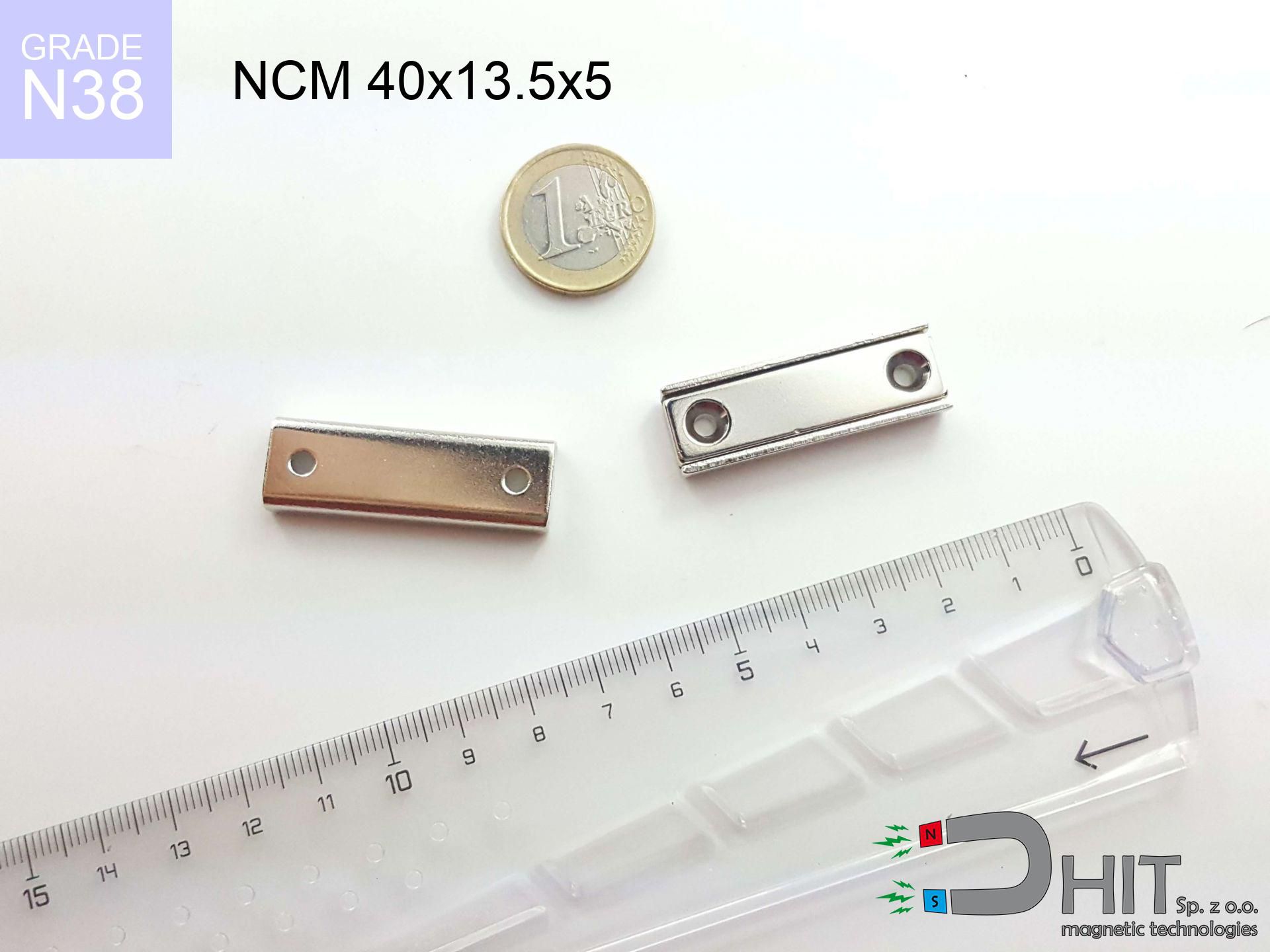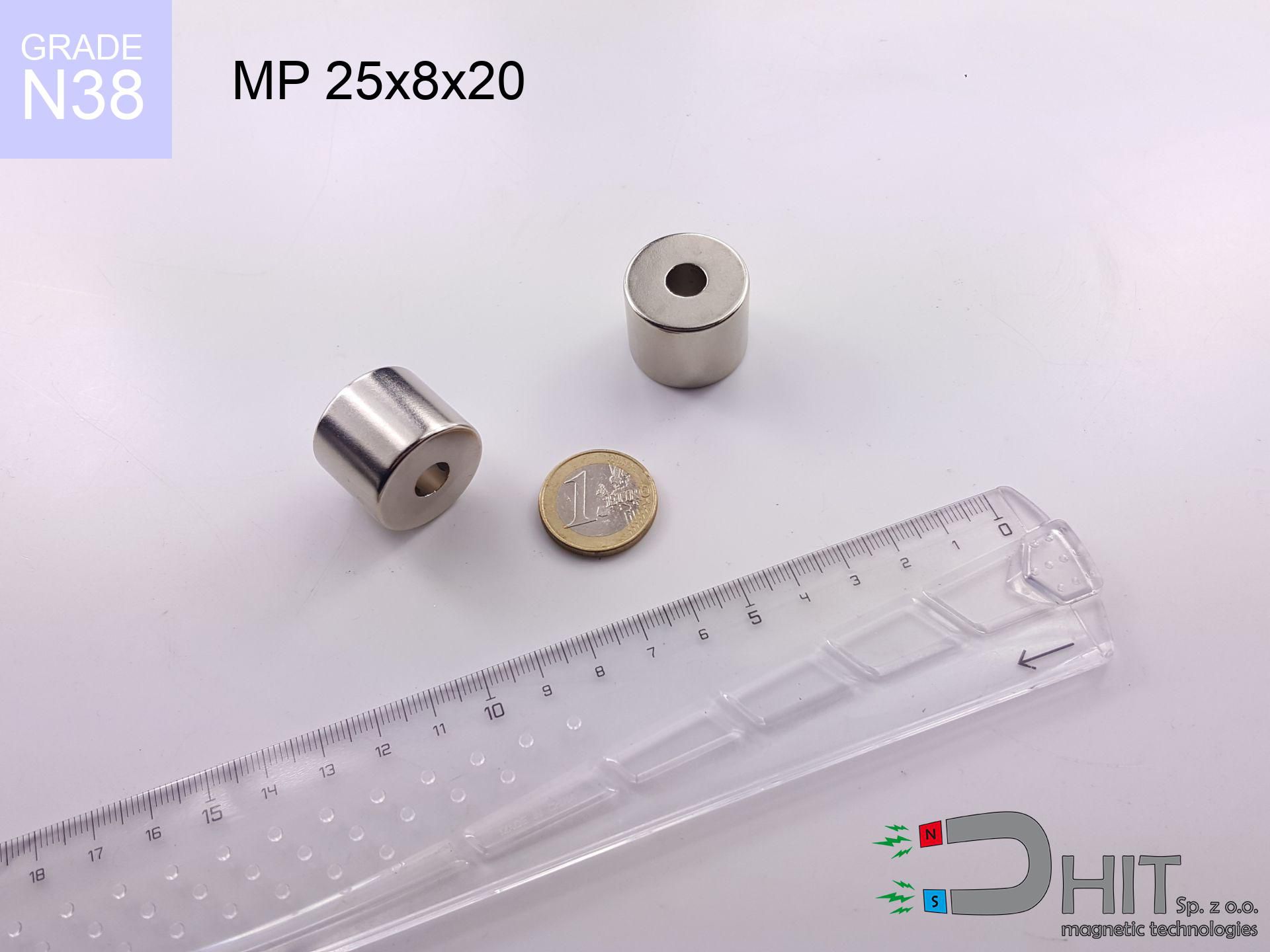NCM 40x13.5x5 / N38 - channel magnetic holder
channel magnetic holder
Catalog no 360489
GTIN/EAN: 5906301814887
Diameter Ø
40 mm [±1 mm]
Height
13.5 mm [±1 mm]
Weight
18.4 g
Magnetization Direction
↑ axial
Load capacity
17.00 kg / 166.71 N
Coating
[NiCuNi] Nickel
14.19 ZŁ with VAT / pcs + price for transport
11.54 ZŁ net + 23% VAT / pcs
bulk discounts:
Need more?
Call us now
+48 22 499 98 98
if you prefer let us know via
request form
through our site.
Lifting power and shape of magnetic components can be verified on our
magnetic mass calculator.
Orders placed before 14:00 will be shipped the same business day.
Physical properties - NCM 40x13.5x5 / N38 - channel magnetic holder
Specification / characteristics - NCM 40x13.5x5 / N38 - channel magnetic holder
| properties | values |
|---|---|
| Cat. no. | 360489 |
| GTIN/EAN | 5906301814887 |
| Production/Distribution | Dhit sp. z o.o. |
| Country of origin | Poland / China / Germany |
| Customs code | 85059029 |
| Diameter Ø | 40 mm [±1 mm] |
| Height | 13.5 mm [±1 mm] |
| Weight | 18.4 g |
| Magnetization Direction | ↑ axial |
| Load capacity ~ ? | 17.00 kg / 166.71 N |
| Coating | [NiCuNi] Nickel |
| Manufacturing Tolerance | ±1 mm |
Magnetic properties of material N38
| properties | values | units |
|---|---|---|
| remenance Br [min. - max.] ? | 12.2-12.6 | kGs |
| remenance Br [min. - max.] ? | 1220-1260 | mT |
| coercivity bHc ? | 10.8-11.5 | kOe |
| coercivity bHc ? | 860-915 | kA/m |
| actual internal force iHc | ≥ 12 | kOe |
| actual internal force iHc | ≥ 955 | kA/m |
| energy density [min. - max.] ? | 36-38 | BH max MGOe |
| energy density [min. - max.] ? | 287-303 | BH max KJ/m |
| max. temperature ? | ≤ 80 | °C |
Physical properties of sintered neodymium magnets Nd2Fe14B at 20°C
| properties | values | units |
|---|---|---|
| Vickers hardness | ≥550 | Hv |
| Density | ≥7.4 | g/cm3 |
| Curie Temperature TC | 312 - 380 | °C |
| Curie Temperature TF | 593 - 716 | °F |
| Specific resistance | 150 | μΩ⋅cm |
| Bending strength | 250 | MPa |
| Compressive strength | 1000~1100 | MPa |
| Thermal expansion parallel (∥) to orientation (M) | (3-4) x 10-6 | °C-1 |
| Thermal expansion perpendicular (⊥) to orientation (M) | -(1-3) x 10-6 | °C-1 |
| Young's modulus | 1.7 x 104 | kg/mm² |
Material specification
| iron (Fe) | 64% – 68% |
| neodymium (Nd) | 29% – 32% |
| boron (B) | 1.1% – 1.2% |
| dysprosium (Dy) | 0.5% – 2.0% |
| coating (Ni-Cu-Ni) | < 0.05% |
Environmental data
| recyclability (EoL) | 100% |
| recycled raw materials | ~10% (pre-cons) |
| carbon footprint | low / zredukowany |
| waste code (EWC) | 16 02 16 |
See also offers
Pros as well as cons of neodymium magnets.
Pros
- They retain attractive force for almost ten years – the loss is just ~1% (according to analyses),
- Neodymium magnets prove to be highly resistant to loss of magnetic properties caused by external interference,
- By using a reflective coating of silver, the element has an professional look,
- Magnets are characterized by extremely high magnetic induction on the surface,
- Thanks to resistance to high temperature, they can operate (depending on the shape) even at temperatures up to 230°C and higher...
- Thanks to flexibility in constructing and the capacity to adapt to complex applications,
- Wide application in high-tech industry – they serve a role in computer drives, drive modules, medical devices, as well as complex engineering applications.
- Thanks to efficiency per cm³, small magnets offer high operating force, occupying minimum space,
Cons
- At strong impacts they can break, therefore we advise placing them in steel cases. A metal housing provides additional protection against damage, as well as increases the magnet's durability.
- We warn that neodymium magnets can reduce their power at high temperatures. To prevent this, we advise our specialized [AH] magnets, which work effectively even at 230°C.
- Due to the susceptibility of magnets to corrosion in a humid environment, we advise using waterproof magnets made of rubber, plastic or other material resistant to moisture, when using outdoors
- Limited ability of making nuts in the magnet and complex forms - recommended is a housing - mounting mechanism.
- Possible danger related to microscopic parts of magnets pose a threat, in case of ingestion, which is particularly important in the context of child health protection. Additionally, tiny parts of these magnets can disrupt the diagnostic process medical after entering the body.
- High unit price – neodymium magnets cost more than other types of magnets (e.g. ferrite), which can limit application in large quantities
Lifting parameters
Maximum magnetic pulling force – what it depends on?
- with the application of a yoke made of special test steel, guaranteeing maximum field concentration
- with a thickness minimum 10 mm
- with a surface cleaned and smooth
- without any insulating layer between the magnet and steel
- under axial application of breakaway force (90-degree angle)
- at room temperature
Key elements affecting lifting force
- Gap (betwixt the magnet and the metal), as even a tiny distance (e.g. 0.5 mm) leads to a decrease in force by up to 50% (this also applies to paint, corrosion or debris).
- Pull-off angle – remember that the magnet holds strongest perpendicularly. Under sliding down, the holding force drops significantly, often to levels of 20-30% of the nominal value.
- Plate thickness – insufficiently thick plate causes magnetic saturation, causing part of the flux to be escaped to the other side.
- Plate material – low-carbon steel attracts best. Alloy admixtures lower magnetic properties and holding force.
- Base smoothness – the more even the plate, the larger the contact zone and stronger the hold. Unevenness acts like micro-gaps.
- Thermal environment – heating the magnet causes a temporary drop of induction. It is worth remembering the thermal limit for a given model.
Lifting capacity testing was performed on plates with a smooth surface of optimal thickness, under perpendicular forces, however under shearing force the holding force is lower. In addition, even a minimal clearance between the magnet and the plate decreases the load capacity.
Safety rules for work with NdFeB magnets
Medical interference
People with a ICD should maintain an safe separation from magnets. The magnetism can interfere with the operation of the life-saving device.
Mechanical processing
Powder generated during grinding of magnets is self-igniting. Do not drill into magnets unless you are an expert.
Caution required
Before starting, check safety instructions. Sudden snapping can break the magnet or hurt your hand. Think ahead.
Keep away from children
Only for adults. Tiny parts pose a choking risk, leading to intestinal necrosis. Store away from children and animals.
Heat warning
Keep cool. NdFeB magnets are susceptible to heat. If you require operation above 80°C, look for special high-temperature series (H, SH, UH).
Compass and GPS
A powerful magnetic field disrupts the functioning of magnetometers in smartphones and GPS navigation. Do not bring magnets near a smartphone to prevent damaging the sensors.
Magnetic media
Device Safety: Neodymium magnets can damage payment cards and sensitive devices (heart implants, hearing aids, mechanical watches).
Magnet fragility
Despite metallic appearance, neodymium is delicate and not impact-resistant. Avoid impacts, as the magnet may shatter into hazardous fragments.
Warning for allergy sufferers
It is widely known that nickel (standard magnet coating) is a potent allergen. If you have an allergy, prevent direct skin contact and opt for coated magnets.
Hand protection
Protect your hands. Two powerful magnets will snap together immediately with a force of massive weight, destroying anything in their path. Be careful!




![UI 45x13x6 [C321] / N38 - badge holder UI 45x13x6 [C321] / N38 - badge holder](https://cdn3.dhit.pl/graphics/products/ui45x13x6-c321-jic.jpg)

![UMGZ 75x34x18 [M10] GZ / N38 - magnetic holder external thread UMGZ 75x34x18 [M10] GZ / N38 - magnetic holder external thread](https://cdn3.dhit.pl/graphics/products/umgw-75x34x18-m10-gz-xid.jpg)

